| Host Plant and Non-plant Specialists -- Acorns to Hemlocks
|
The main reason the lepidoptera, and most
particularly the moths, have become so numerous and diverse as
species, is that they have found so many ways for their larvae to
exploit the world of plants and to divide that world into specialized
uses of plant parts. Some moth specialize in munching foliage from
without and within (leafminers). Others live mainly as borers within
the stems or stalks of low-growing plants or in the trunks of trees.
Still others exploit root systems, fruits, buds, cones, seeds and
other plant parts. A much smaller group of moths make their livings in
other ways, developing through the use of lichens, fungi, beehives,
animal fur and even the stored products of man.
In my yard and
garden I can discover at least one species of moth that utilizes
almost every plant that I can identify including my lawn grasses and
weeds, every ornamental shrub, perennial and annual flowering plant
and vine, and vegetable raised for our own consumption. There have
also been a few species that are occasionally found in our kitchen and
pantry and in the produce brought home from the supermarket. All in
all it is really no surprise to have so far found more than 700
species of adult moths in my yard. Many of them are shown in the
listing that follows below.
|
|
Acorns |
Ailanthus |
Apple |
Apple | |
 Valentina glandulella
Valentina glandulella
© Robert
Patterson - MD
|
 Atteva punctella
Atteva punctella
© Richard Leung
- VA
|
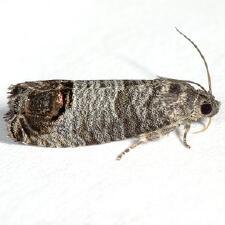 Cydia pomonella
Cydia pomonella
© Nolie
Schneider - ON
|
 Sphinx gordius
Sphinx gordius
© John Himmelman
- CT
| |
|
Azalea |
Basswood |
Beeswax |
Beet | |
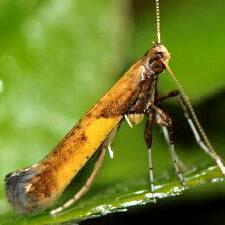 Caloptilia azaleella
Caloptilia azaleella
© Richard
Leung - VA
|
 Olethreutes tiliana
Olethreutes tiliana
© Janice
Stiefel - WI
|
 Gelleria mellonella
Gelleria mellonella
© Anthony W.
Thomas - NB
|
 Hymenia perspectalis Hymenia perspectalis
© Robert Patterson - MD
| |
|
Birch |
Birch |
Blackberry |
Bougainvillea | |
 Eriocrania semipurpella
Eriocrania semipurpella
©
Anthony W. Thomas - NB
|
 Acronicta betulae
Acronicta betulae
© Robert
Patterson - MD
|
 Chlorchlamys chloroleucaria
Chlorchlamys chloroleucaria
©
Alan Chin-Lee - FL
|
 Asciodes gordialis
Asciodes gordialis
© Machele
White - FL
| |
|
Boxwood |
Bunchberry |
Burdock |
Cabbage | |
 Galasa nigrinodis
Galasa nigrinodis
© Machele
White - FL
|
 Olethreutes connectus
Olethreutes connectus
© Robert
Patterson - MD
|
 Papaipema cataphracta
Papaipema cataphracta
© Robert
Patterson - MD
|
 Evergestis pallidata
Evergestis pallidata
© Nolie
Schneider - ON
| |
|
Catalpa |
Celery |
Chickweed |
Chinquapin | |
 Ceratomia catalpae
Ceratomia catalpae
© Robert
Patterson - MD
|
 Udea rubigalis
Udea rubigalis
© John Davis - WA
|
 Haematopis grataria
Haematopis grataria
© Robert
Patterson - MD
|
 Dyseriocrania griseocapitella
Dyseriocrania griseocapitella
©
Robert Patterson - MD
| |
|
Citrus |
Clothing |
Clover |
Clover | |
 Gonodonta nutrix Gonodonta nutrix
©
Robert Patterson - MD
|
 Tinea pallescentella
Tinea pallescentella
© Ben Smart
- UK
|
 Plathypena scabra
Plathypena scabra
© Matthew Roth
- PA
|
 Hypsopygia costalis
Hypsopygia costalis
© Anthony W.
Thomas - NB
| |
|
Columbine |
Corn |
Corn |
Cotton | |
 Papaipema leucostigma
Papaipema leucostigma
© Dave
Beadle - ON
|
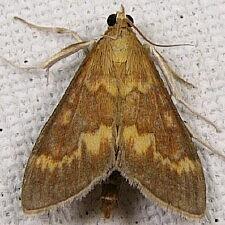 Ostrinia nubilialis Ostrinia nubilialis
©
Robert Patterson - MD
|
 Helicoverpa zea
Helicoverpa zea
© Lynette
Schimming - NC
|
 Crocidosema plebejana
Crocidosema plebejana
© Machele
White - FL
| |
|
Currant |
Dead Wood |
Dogwood |
Douglas Fir | |
 Synanthedon tipuliformis
Synanthedon tipuliformis
© Shane
Farrell - UK
|
 Scolecocampa liburna
Scolecocampa liburna
© Robert
Patterson - MD
|
 Euthyatira pudens
Euthyatira pudens
© Bob Duncan -
NY
|
 Orgyia pseudotsugata
Orgyia pseudotsugata
© John
Davis - WA
| |
|
Eggplant |
Elder |
Elm |
Euonymus - Spindle
| |
 Lineodes integra
Lineodes integra
© Charles
Lewallen - OK
|
 Achatodes zeae
Achatodes zeae
© Forest Barnas -
MN
|
 Ceratomia amyntor
Ceratomia amyntor
© Patrick Coin
- NC
|
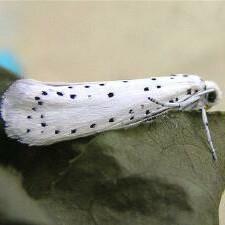 Yponomeuta cagnagella
Yponomeuta cagnagella
© Carroll
Rudy - WI
| |
|
Evergreens |
Fern |
Fig |
Filbert | |
 Thyridopteryx ephemeraeformis
Thyridopteryx ephemeraeformis
©
Robert Patterson - MD
|
 Callopistria mollissima
Callopistria mollissima
© John
Himmelman - CT
|
 Xanthopastis timais Xanthopastis timais
©
Robert Patterson - MD
|
 Cydia latiferreana
Cydia latiferreana
© Robert
Patterson - MD
| |
|
Finned-willow |
Fireweed |
Fringe-tree |
Fungus | |
 Notodonta scitipennis
Notodonta scitipennis
© Cindy
Mead - MI
|
 Mompha conturbatella
Mompha conturbatella
© Ben Smart
- UK
|
 Adita chionanthi
Adita chionanthi
© Nolie
Schneider - ON
|
 Metalectra quadrisignata
Metalectra quadrisignata
©
Robert Patterson - MD
| |
|
Gaillardia |
Goldenrod |
Goosefoot |
Gorse | |
 Schinia masoni
Schinia masoni
© Charles
Lewallen - OK
|
 Schinia nundina
Schinia nundina
© Tom Murray -
MA
|
 Chrysoesthia drurella
Chrysoesthia drurella
© Nigel
Whinney - UK
|
 Agonopterix nervosa
Agonopterix nervosa
© John Davis
- WA
| |
|
Grape |
Grasses |
Grasses |
Hemlock | |
 Desmia funeralis
Desmia funeralis
© Machele White
- FL
|
 Acrolophus plumifrontella
Acrolophus plumifrontella
©
Robert Patterson - MD
|
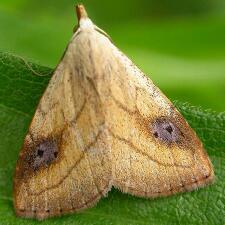 Rivula propinqualis
Rivula propinqualis
© Bev Wigney
- ON
|
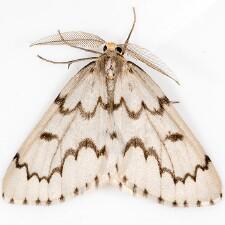 Nepytia phantasmaria
Nepytia phantasmaria
© John
Davis - WA
| |
 Valentina glandulella
Valentina glandulella  Atteva punctella
Atteva punctella  Cydia pomonella
Cydia pomonella  Sphinx gordius
Sphinx gordius  Caloptilia azaleella
Caloptilia azaleella  Olethreutes tiliana
Olethreutes tiliana  Gelleria mellonella
Gelleria mellonella  Hymenia perspectalis
Hymenia perspectalis
 Eriocrania semipurpella
Eriocrania semipurpella  Acronicta betulae
Acronicta betulae  Chlorchlamys chloroleucaria
Chlorchlamys chloroleucaria  Asciodes gordialis
Asciodes gordialis  Galasa nigrinodis
Galasa nigrinodis  Olethreutes connectus
Olethreutes connectus  Papaipema cataphracta
Papaipema cataphracta  Evergestis pallidata
Evergestis pallidata  Ceratomia catalpae
Ceratomia catalpae  Udea rubigalis
Udea rubigalis  Haematopis grataria
Haematopis grataria  Dyseriocrania griseocapitella
Dyseriocrania griseocapitella  Gonodonta nutrix
Gonodonta nutrix  Tinea pallescentella
Tinea pallescentella  Plathypena scabra
Plathypena scabra  Hypsopygia costalis
Hypsopygia costalis  Papaipema leucostigma
Papaipema leucostigma  Ostrinia nubilialis
Ostrinia nubilialis  Helicoverpa zea
Helicoverpa zea  Crocidosema plebejana
Crocidosema plebejana  Synanthedon tipuliformis
Synanthedon tipuliformis  Scolecocampa liburna
Scolecocampa liburna  Euthyatira pudens
Euthyatira pudens  Orgyia pseudotsugata
Orgyia pseudotsugata  Lineodes integra
Lineodes integra  Achatodes zeae
Achatodes zeae  Ceratomia amyntor
Ceratomia amyntor  Yponomeuta cagnagella
Yponomeuta cagnagella  Thyridopteryx ephemeraeformis
Thyridopteryx ephemeraeformis  Callopistria mollissima
Callopistria mollissima  Xanthopastis timais
Xanthopastis timais  Cydia latiferreana
Cydia latiferreana  Notodonta scitipennis
Notodonta scitipennis  Mompha conturbatella
Mompha conturbatella  Adita chionanthi
Adita chionanthi  Metalectra quadrisignata
Metalectra quadrisignata  Schinia masoni
Schinia masoni  Schinia nundina
Schinia nundina  Chrysoesthia drurella
Chrysoesthia drurella  Agonopterix nervosa
Agonopterix nervosa  Desmia funeralis
Desmia funeralis  Acrolophus plumifrontella
Acrolophus plumifrontella  Rivula propinqualis
Rivula propinqualis  Nepytia phantasmaria
Nepytia phantasmaria